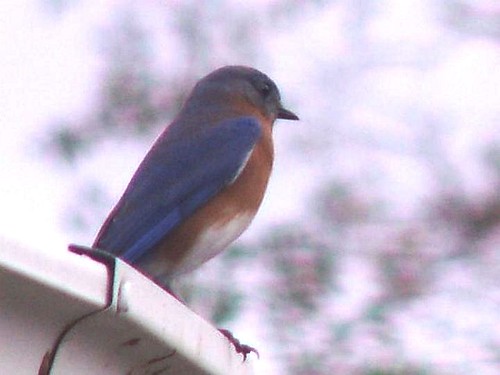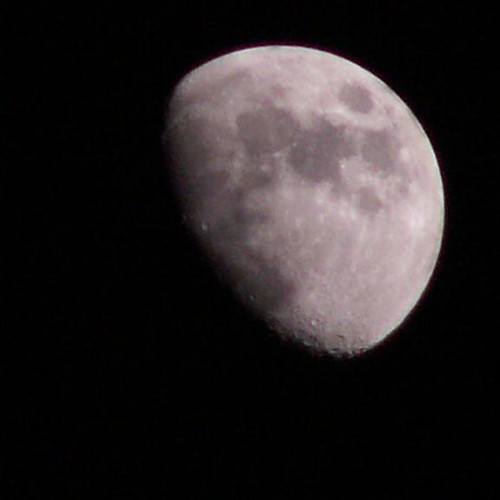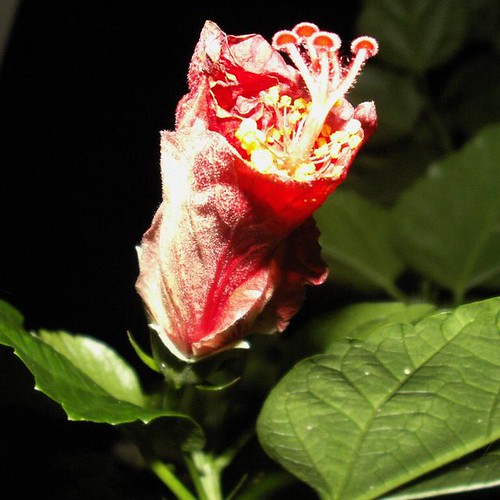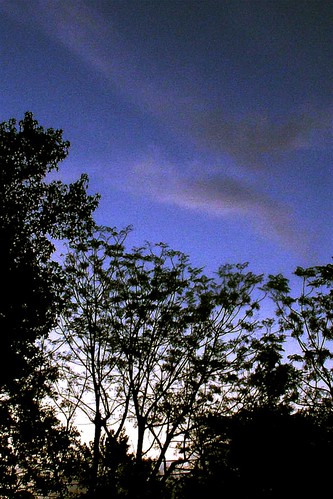Bluebirds of Happiness and Other Tidbits

"Two little birds," Mary whispered urgently. We were sitting on the couch as our TV blared the closing credits of a Star Trek: The Next Generation rerun. "One's at the corner of the gutter."
I peeked out quickly. "Bluebirds." Ran for the camera.
I squeezed off five shots through the window before they took off. This one's a male; the more subdued-colored female is out of frame to the left. Beside me Daisy sat on the couch back, chittering excitedly. Three out of the five photos blurred the birds; the remaining picture shows the back of this one's head. (You can see a more subdued-colored female Eastern Bluebird here.)
In the spring of 2004, after I'd planted four trees in the yard, a male bluebird came and perched on top of one of our two red maples. The day back then had been sunny, unlike our current clouds, and I thrilled to a blue of extraordinary iridescence. I had never seen a bluebird in person before then.
I don't know if there are more around or if I'm just recognizing them more often. On our walk a few days ago we'd seen more than a dozen on a wire, in the rain; I recognized them by their ruddy chests and just a touch of blue. Light quality makes a difference, because a bluebird's feathers aren't "blue" per se but reflect blue wavelengths. Writes John Ivanko in Michigan Today:
The bluebirds' color was so remarkable to Henry David Thoreau that he felt compelled to describe this species' coloring as 'carrying the sky on its back.' An insightful description since the bluebird's blue color does, in fact, come from light waves scattered by the structure of their feathers, not from blue pigment in their feathers-a blue suncatcher, so to speak. That's why a bluebird appears gray on an overcast day.

I finally discovered that night -- Friday the 9th -- that my camera and software remember the settings for each photo! And, more important, how to access the info. No need to pack the tape recorder after all.
I had stepped outside just prior to our walk and spotted this then-8-day-old moon almost 37 hours after first quarter. The first shot, taken at 5:15 PM EST, uses the auto settings -- a 1/250-second exposure at f/8 -- and shows the sky realistically. As bright as this first shot is, I like its crater definition at the terminator. (Clicking on the photo will bring up a larger shot.)
The sky had been darker at the same time in my old Boston stomping grounds. Up there sunset occurred at 4:12 PM; here the sun had set at 5:33 PM.
The next two exposures, with an artificially-darkened sky, were taken two minutes later and are 1/400-second at f/4.5 and 1/1000-second at f/5, respectively. I had taken all three without a tripod.
The sky had cleared but was still filled with high, wispy clouds and contrails. By the time we got back from our walk the haze had thickened considerably, so I'm glad to have grabbed the opportunity when I did.
When I first posted this three-part photo I hadn't realized that this particular moon had also been at the juncture of three celestial planes! Not only was it on the celestial equator, but it was also on its ascending node as it moved from south to north of the ecliptic.
The Old Farmer's Almanac defines the celestial equator as, "The circle around the celestial sphere that is halfway between the celestial poles. It can be thought of as the plane of Earth's equator projected out onto the sphere." The celestial sphere is, "An imaginary sphere projected into space that represents the entire sky, with the observer on Earth at its center. All celestial bodies other than Earth are imagined as being on its inside surface."
But the celestial equator is tilted relative to the ecliptic. The OFA defines the ecliptic as, "The apparent annual path of the Sun around the celestial sphere." It adds, "The plane of the ecliptic is tipped 23-1/2 degrees from the celestial equator," because the Earth is tipped 23-1/2 degrees on its axis.
(You can see representations of the celestial equator and ecliptic here -- although this image of celestial spheres is my personal favorite.)
The Moon itself follows neither the celestial equator nor the ecliptic exactly, but is tipped about 5 degrees with respect to the ecliptic. So it crosses the ecliptic from south to north (ascending) and north to south (descending) for each of its orbits around the Earth. These crossing points are nodes, and they're also where eclipses happen, since the ecliptic is the path we see the Sun take. If the Moon is on a node when it is New -- standing, as it were, between the Earth and the Sun -- it blocks the Sun from our view. If it is on a node when it is Full, it falls into the Earth's shadow.
So, three planes -- the celestial equator, the ecliptic, and the orbital path of the Moon, all had intersections on Friday!

According to Calculator Cat's terrific moon phases module (which I first discovered at Velveteen Rabbi's site), the Moon in this shot is 77% of full. The sky here is artificially darkened as a result of the camera settings; it was still light when I was out with my tripod yesterday at 5:46 PM EST. (There will be no moon shots tonight unless the sky around here does some serious clearing up.)

Mary spotted this curled-up hibiscus flower after dark at the local strip mall, near where I'd photographed an open flower during daylight back in September. I took this one with flash.

This is what I saw from my back porch last night, though I've fiddled a bit with contrast and sharpening.











2 Comments:
Every time I see a bluebird I consider it a magical sighting. I think "Oh the bluebird of happiness" and then I feel happy and cured of all worry and stress. We have some indigo buntings here.
Hi! Most delighted to discover your blog, which I found by googling "celestial spheres", looking for this very pic (the one you say is your favourite image of them). I've always loved it but had no idea where I'd seen it or how I would ever find it again ... so thanks. Do you have any idea what the source /date of this image is? I'd love to know.
Oh, and happy new year (from South Africa)
Henrietta hri@absamail.co.za
Post a Comment
<< Home